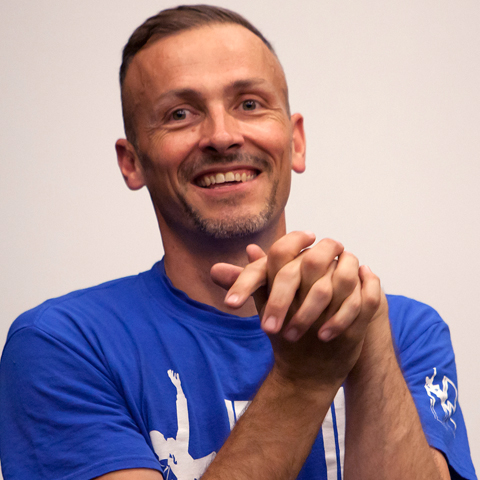How Parkour can breathe life into communities
Date posted: 08 August 2017
People Dancing caught up with Performance-Parkour (2PK) specialist Alister O’Loughlin at this year’s Summer School, following his session as part of the Exploring different dance techniques for your practice course.

They say beauty is in the eye of the beholder. Keats’ Grecian Urn pronounced “beauty is truth, truth beauty.” For Alister O’Loughlin, of The Urban Playground Team (pictured right), the point of beauty is reached when someone both moves and smiles.
Alister is keen to suggest community dance practitioners are best placed to lead classes in the 2PK version of Parkour, a form of movement that became a youth marketer’s dream… but at the expense of a major misunderstanding of the values of a scene that emerged from the suburbs of Paris to be adopted by a global youth culture.
Anyone whose view of Parkour had been shaped by all-action, macho commercials of young guys leaping across high-rise rooftops – and that would be most of us – would have been surprised and delighted by the gentle beauty of a sequence of movement created around a set of metal frames and gym furniture presented by 2PK debutants at our 2017 Summer School.
The movement was carefully group choreographed and quietly executed by the delegates, while the smiles came when they achieved a testing but successful routine, particularly when each dancer found a way through one framed space that appeared little larger than a letterbox. This was clearly an act of community, of making, creating, sharing, supporting and performing within a group.
Alister explained to us there is a difference between the highly charged, and often competitive, largely solo practice of Parkour and 2PK, the quieter, choreographed form of Parkour pioneered by Alister with his Urban Playground Team co-directors Miranda Henderson and (the co-creator of Parkour) Malik Diouf.
“At Urban Playground Team our work is focused particularly on at-risk communities,” said Alister, “to catalyse creative movement, especially for those who are maybe not used to the arts, or don’t see culture as being something that’s aimed towards them.
“Rather like the original dance animateurs, through 2PK we can breathe life into a community by enlivening and encouraging dance and movement. We’re not part of the sportisation process that sees Parkour heading towards the Olympics as an elite sport; rather, we’re interested in making the work as accessible to the largest number of participants possible.
“We find this particularly applies when we’re achieving what we call the ‘re-visioning’ of young people, many of whom are dismissed as underachievers. Through 2PK we reintroduce them to their community as performers and artists.”
But it’s not only disadvantaged young people that Performance-Parkour benefits, says Alister. He talked of ‘Silver Parkour’ and the way it’s helping older people regain and monitor movement, similar to an occupational therapist working with their patients to avoid falls. He also discussed the power of Performance-Parkour to help people with their mental as well as physical health.
Our conversation even turned to a role for Parkour in addressing ‘helicopter parenting’ and a diminished risk intelligence that exists in today’s society: “Young people do Parkour completely naturally,” said Alister, “they just need to be told it’s OK.”
To Alister, 2PK can be a beacon of inclusive dance: “It celebrates the notion that it’s OK to move differently, it expresses togetherness, it builds people’s confidence – whatever their age or situation, and it gets people to both move and smile,” he affirms.
Moreover, Alister perhaps belies his own super fit, PE Instructor looks when he says, “There is no room in this game for drill sergeants – it’s about students and teachers learning from each other.”